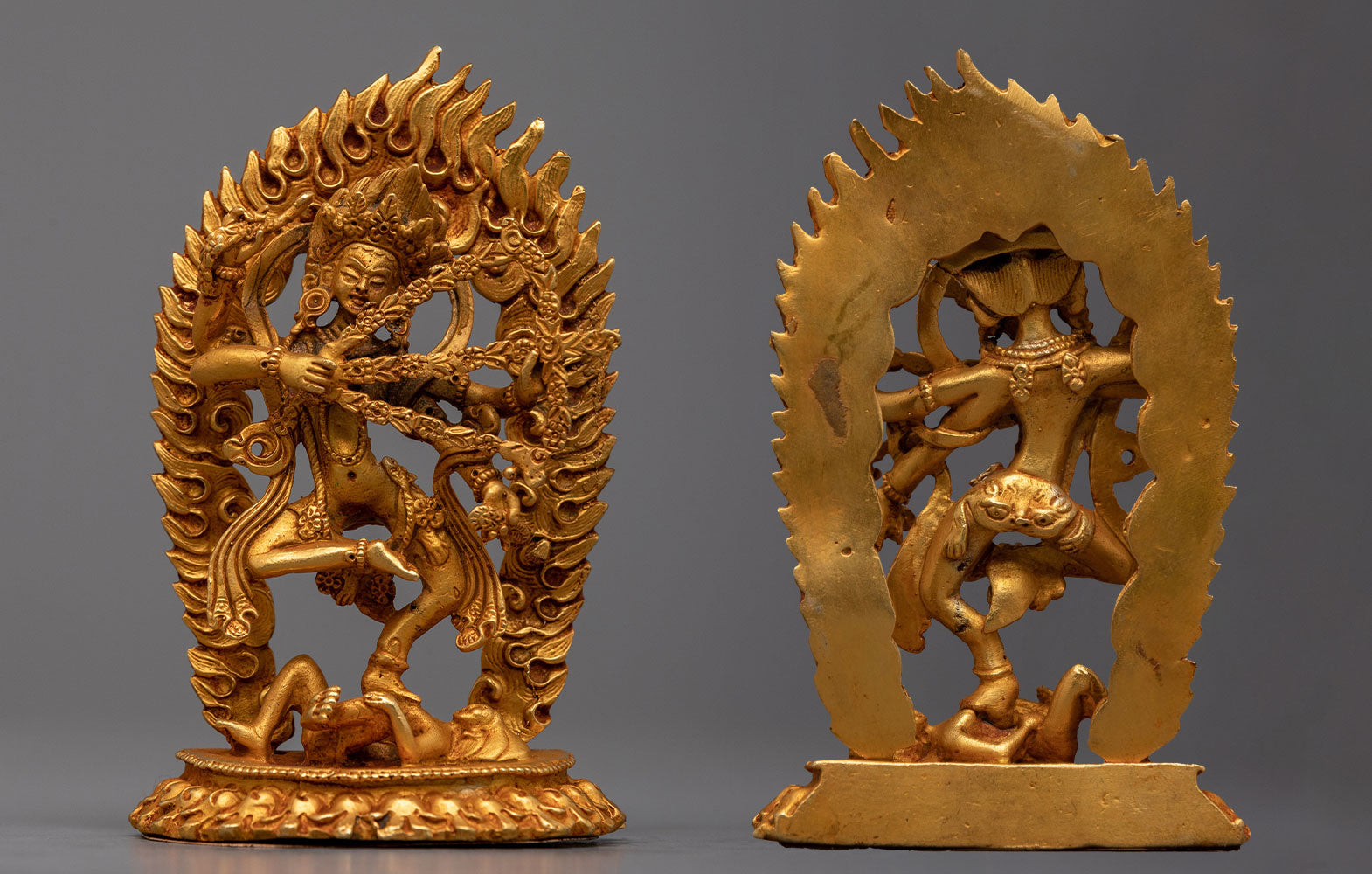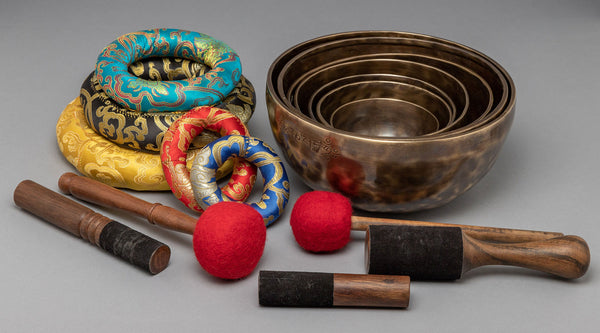Devi Kurukulla: The Enchantress of Tibetan Buddhism
In the rich tapestry of Tibetan Buddhism, Devi Kurukulla emerges as a fascinating and complex deity, embodying the power of enchantment, magnetism, and the subjugation of opposing forces.
Often depicted as a red goddess wielding a bow and arrow, her imagery and symbolism are deeply rooted in the esoteric teachings of Vajrayana Buddhism.
Kurukulle embodies the essence of action and knowledge, with "Kuru" signifying the power of creation and destruction, and "Kulla" representing traditions and systems of knowledge.
Pronounced as "koo roo koo lah," Kurukulla is revered as a deity endowed with limitless magical prowess. Within Vajrayana Buddhism, she holds the esteemed position as the patron of enchantment, magnetism, and love. Among Tibetan practitioners, she is affectionately known as 'Rigjema' or the 'Mistress of Knowledge.'
Key Takeaways
- Kurukulla is a Tibetan Buddhist deity known for her enchantment and magnetism powers.
- She is often depicted in a red form, symbolizing desire and transformation.
- Kurukulla practices are associated with overcoming obstacles and attracting beneficial conditions.
- Her iconography includes a flower bow and arrow, signifying the subjugation of opposing forces through the power of attraction.
- Kurukulla's worship is linked to the broader themes of wisdom, power, and seduction in Buddhist philosophy.
Origins and Historical Development

Click here to view our Kurukulla Thangka
The Early References
Initially appearing as a minor deity in early Buddhist Tantras, Dakini Kurukulla later emerges as a pivotal figure in the Vajrayana tradition. Originating from Indian Buddhism, she was initially linked with magical arts and the ensnarement of others. However, her significance grew over time, particularly within Tibetan Buddhism.
Integration into Tibetan Buddhism
Within the Tibetan Buddhist framework, Kurukulla is frequently linked with Tara, notably Red Tara, demonstrating a fusion of deities and rituals.
This integration underscores the adaptive essence of Buddhist practice, wherein divine entities evolve and blend within the spiritual landscape, mirroring practitioners' changing needs and cultural milieu.
Iconography and Symbolism of Goddess Kurukulle
Physical Attributes
Kurukulla is often portrayed as a youthful and captivating woman, embodying vitality and allure that reflect her essence. Her appearance goes beyond mere aesthetics; it symbolizes the qualities she represents and the spiritual truths she embodies.
- Color: Kurukulle is typically depicted in a vibrant red hue, a crucial aspect of her iconography. Red symbolizes passion, power, and the transformation of desire into wisdom, reflecting Kurukulla's mastery over love and lust.
- Posture: She is commonly shown dancing, symbolizing her active engagement and mastery of the world. This dynamic stance signifies Kurukulla's ability to navigate life's complexities with grace and power.
- Facial Expression: Kurukulla's face often bears a serene yet seductive smile, embodying the fusion of wisdom and compassion. Her expression invites devotion and meditation, guiding practitioners toward realizing emptiness and compassion.
Iconographic Symbols
Kurukulla's iconography is rich with symbols, each carrying deep spiritual significance. These symbols represent her qualities and activities and serve as tools for meditation, helping practitioners embody them.
- Four Arms: Kurukulla is often depicted with four arms, representing the four immeasurables in Buddhism: love, compassion, joy, and equanimity. Each hand holds symbolic objects that reflect aspects of her practice and teachings.
- Bow and Arrow: One pair of her hands usually holds a bow and arrow crafted from flowers, typically lotuses, symbolizing the transformation of desire into the path of enlightenment. This imagery illustrates Kurukulla's ability to pierce hearts with the arrows of wisdom and compassion, guiding beings toward spiritual awakening.
- Hook and Noose: Her other pair of hands typically carries a hook and a noose, which are also made of flowers. The hook symbolizes her capacity to attract beings to the Dharma, leading them to liberation. At the same time, the noose represents her ability to subdue hostile forces and obstacles on the path to enlightenment.
- Lotus Flower: Kurukulla is often depicted standing or seated on a lotus flower, a symbol of purity and enlightenment in Buddhism. This imagery conveys the transcendence of worldly impurities and the attainment of wisdom amidst the challenges of samsara.
- Jewelry and Ornaments: Adorned with various jewels and ornaments, Kurukulla's attire symbolizes the abundance of virtues and the magnificence of realization. Additionally, her jewelry serves as a reminder of the impermanence of material wealth, emphasizing the cultivation of inner spiritual riches.
The Dance of Dakini Kurukulla
The Dance of Kurukulla embodies the dynamic relationship between wisdom and compassion, symbolizing the joyful manifestation of enlightenment. Through her dance, Kurukulla encourages practitioners to view the world not as a source of attachment and suffering but as a realm for cultivating compassion and realizing wisdom.
Kurukulle Mantra
Click here to view our Dakini Kurukulle Statue
"OM KURUKULLE HRIH SVAHA"
-
OM:
OM holds sacred significance in Indian religions, symbolizing the essence of ultimate reality, consciousness, or Atman. At the onset of many mantras, it is an invocation and a divine call to attention. -
KURUKULLE:
Practitioners invoke this deity. By chanting her name, they seek Kurukulla's energy and blessings directly. -
HRIH:
The seed syllable associated with Amitabha Buddha, is frequently utilized in practices emphasizing compassion and profound insight. Within the context of Kurukulla, HRIH underscores the transformation of desire into wisdom and compassion, reflecting her connection to Amitabha and her role in guiding attachment towards enlightenment. -
SVAHA:
It serves as an offering formula in Buddhist and Hindu rituals, marking the conclusion of the mantra. It dedicates the recitation to Kurukulla and the assembly of deities, channeling the generated merit for the welfare of all sentient beings.
Benefits of Reciting Kurukulla's Mantra
Reciting Kurukulla's mantra is believed to yield various spiritual and worldly benefits, aligning with her qualities and the practitioner's intentions. These benefits encompass:
- Overcoming Obstacles: The mantra aids in overcoming obstacles hindering spiritual growth, including external challenges and internal afflictions like anger, jealousy, and ignorance.
- Attracting Beneficial Conditions: Practitioners believe the mantra attracts favorable circumstances in life, such as wealth, love, and success, fostering supportive conditions for their spiritual journey.
- Enhancing Charm and Magnetism: Kurukulla's mantra infuses practitioners with a captivating quality, enhancing their persuasiveness and charisma in interactions.
- Developing Compassion and Wisdom: A more profound mantra supports the transformation of desire into enlightenment, fostering a profound understanding of the Dharma and nurturing compassion and wisdom.
- Spiritual Awakening: Ultimately, the practice aims for enlightenment, benefiting all beings by helping practitioners realize their true nature and the emptiness of all phenomena.
Significance in Practice
-
Overcoming Obstacles:
Practitioners call upon Kurukulla to overcome external and internal obstacles. Her power is believed to be particularly potent in transforming adverse conditions into favorable ones and subduing negative forces that impede spiritual progress. -
Attracting Beneficial Conditions:
In addition to overcoming obstacles, Kurukulla's practices are utilized to attract beneficial conditions, such as wealth, followers, and love. However, these are not pursued for selfish purposes but to facilitate the practitioner's spiritual journey and benefit others. -
Meditation and Visualization:
Meditation on Kurukulla involves detailed visualization of her form and attributes, coupled with the chanting of her mantra. This practice aims to internalize her qualities, transforming the practitioner's mind and heart.
Kurukulla embodies the transformative potential of desire, reshaping the conventional notions of attachment and seduction into catalysts for spiritual liberation.
Her practices offer a route to surmounting obstacles, attracting favorable conditions, and ultimately, realizing the essence of reality itself. In Kurukulla, we discover a profound symbol of the Vajrayana tradition's ability to integrate all facets of human experience into the path of enlightenment.
By delving into the mystique of Kurukulla, both practitioners and scholars can uncover profound insights into the intricate fabric of Tibetan Buddhism. Here, deities inspire devotion and symbolize the inner metamorphoses central to the spiritual odyssey.


